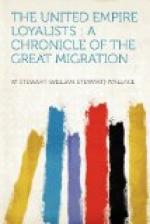With regard to the settlement at Detroit, there is not much evidence available. It was Haldimand’s intention at first to establish a large settlement there, but the difficulties of communication doubtless proved to be insuperable. In the event, however, some of Butler’s Rangers settled there. Captain Bird of the Rangers applied for and received a grant of land on which he made a settlement; and in the summer of 1784 we find Captain Caldwell and some others applying for deeds for the land and houses they occupied. In 1783 the commanding officer at Detroit reported the arrival from Red Creek of two men, ‘one a Girty, the other McCarty,’ who had come to see what encouragement there was to settle under the British government. They asserted that several hundred more would be glad to come if sufficient inducements were offered them, as they saw before them where they were nothing but persecution. In 1784 Jehu Hay, the British lieutenant-governor of Detroit, sent in lists of men living near Fort Pitt who were anxious to settle under the British government if they could get lands, most of them being men who had served in the Highland and 60th regiments. But it is safe to assume that no large number of these ever settled near Detroit, for when Hay arrived in Detroit in the summer of 1784, he found only one Loyalist at the post itself. There had been for more than a generation a settlement of French Canadians at Detroit; but it was not until after 1791 that the English element became at all considerable.
It has been estimated that in the country above Montreal in 1783 there were ten thousand Loyalists, and that by 1791 this number had increased to twenty-five thousand. These figures are certainly too large. Pitt’s estimate of the population of Upper Canada in 1791 was only ten thousand. This is probably much nearer the mark. The overwhelming majority of these people were of very humble origin. Comparatively few of the half-pay officers settled above Montreal before 1791; and most of these were, as Haldimand said, ’mechanics, only removed from one situation to practise their trade in another.’ Major Van Alstine, it appears, was a blacksmith before he came to Canada. That many of the Loyalists were illiterate is evident from the testimony of the Rev. William Smart, a Presbyterian clergyman who came to Upper Canada in 1811: ’There were but few of the U. E. Loyalists who possessed a complete education. He was personally acquainted with many, especially along the St Lawrence and Bay of Quinte, and by no means were all educated, or men of judgment; even the half-pay officers, many of them, had but a limited education.’ The aristocrats of the ‘Family Compact’ party did not come to Canada with the Loyalists of 1783; they came, in most cases, after 1791, some of them from Britain, such as Bishop Strachan, and some of them from New Brunswick and Nova Scotia, such as the Jarvises and the Robinsons. This fact is one which serves to explain a great deal in Upper Canadian history.




